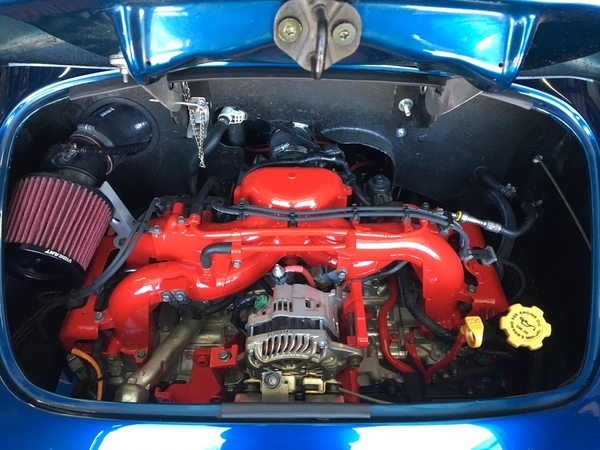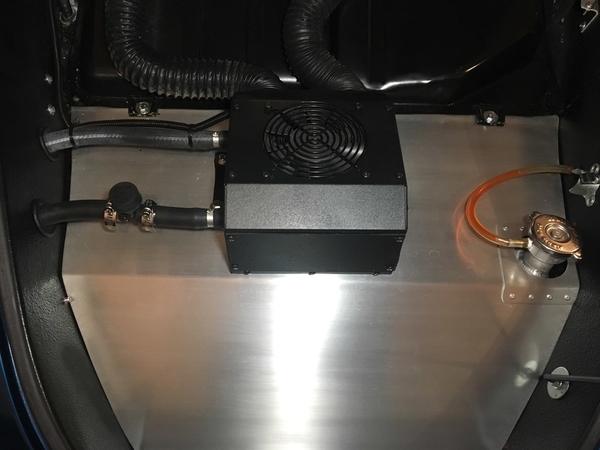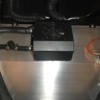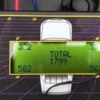I weighed my Subaru Converted Fiberfab Californian Speedster today. It was weighed on a truck scale with an aprrox. 1/2 tank of fuel and the 1/4 . My car has real Fuch wheels and discs brakes on all 4 corners. I also have a heater core and fan but no radio. I was not sure what the car actually weighed buy was guessing at 2000-2100 lbs. The actual weight of the car is 1875 lbs. which is lower than I thought. Does this sound about what others with similar Speedsters are seeing as the weight of their cars?


Replies sorted oldest to newest
You'll get Al's Lightness Seal of Approval with that weight. My SAS coupe probably outweighs you by 500 lbs. or so.
I was about to buy some polished Fuchs replica wheels until I found out the weighed more than double my real Fuchs wheels. I am going to have them restored and polished this winter.
That seems reasonable. My Beck was 1700 pounds, but it didn't have the heavier water-cooled engine, radiator, or associated stuff.
My older pan based Speedster with the Soob and heater core weighed just under 1,800 lbs.
Mine's a little heavier also. ![]()
@Jimmy V. I am right at 1800 lbs.
If all you use your car for is to toodle down to the beach for ice cream then it doesn't matter, but if you care how well it performs then the more effort you put in to weight reduction and balance the more fun it will be. Good choices Jimmy!
Jim Kelly posted:You'll get Al's Lightness Seal of Approval with that weight. My SAS coupe probably outweighs you by 500 lbs. or so.
Bob: IM S6 posted:Mine's a little heavier also.
And yes, they may be a little heavier, boys, but they're both so cool and badass (I'm talkin' off the charts!) that Yoda forgives you this minor indiscretion.![]()
PS- What would be interesting, @Jimmy V., is if you weighed it one axle at a time to find out the front/rear bias...
I was happy with the 1875 lb. weight of the car, now if I can lose 40 lbs my car will be faster. LOL..
If you park on two pads (scales) at a certified truck scale you can get front and rear weights.
I owned a set of corner scales back when I was racing my 914. Corner balancing a car makes a huge difference to improve the handling of a car. I sold them off when I got out of racing.
Carey and Mike have both told me that there is less than 50 pounds difference between Suby and type1 cars. They have open truck scales right down the street.
CMCs tend to weigh anywhere from 1800-2000 depending on the enthusiasm of the chopper-gun guy and how the car is equipped. Lane's 1700 pounds is typical for an aircooled Beck I think, but maybe on the lighter side.
Scales are THE WAY! I've brought mine to Carlisle a couple times, maybe I'll bring them again so guys can get their corner weights.
Love dem scales & gives us something fun to do on the show field.
Another good reason to have adjustable spring plates. ( some on the forum are against them) It makes it possible to fine tune the corner weights. Having individually adjustable front suspension would be nice as well but can be worked around. I am not racing my Speedster but it does make a significant difference in the handling of any car to have it corner balanced.
I think that the only grumps I've heard about adjustable rear spring plates on here is that they tend to weigh somewhat more than the original VW plates.
That said, if you're going to corner balance your car on a set of corner scales, the most sensible way is to have adjustable rear plates.
And as Jimmy said, if we could only separate the front bars - We could, actually, with a set of four Avis adjusters, two front center pucks and then cutting the front torsion leaves in half and then figure out how to keep everything from flyiong apart.
Sounds like a cool winter project..... 🤔
If you have room for them and don't care about the extra weight then adjustable spring plates certainly make fine tuning rear suspension height and corner weights much easier. Don't get me wrong- I can see their usefulness. The adjusting block would not let the 195's on my Fuchs (6's widened to 7's on the inside a la '67 911R) fit and still remain inside the fenders so they had to go. Also, once I got on the weight awareness thing they didn't make any sense (for me). I will have to fine tune via rear spring plate disassembly (as well as removing the trailing arms)- yes, a total pain in the @ss, but it is what it is.
A side benefit- my cut down swingaxle spring plates weigh almost 7 pounds less than the adjustable spring plates (and about 4 1/2 pounds less than early VW irs pieces) while the shorter swingaxle torsion bars are 2 pounds lighter than irs bars.
All that said- I still contend that most people, once ride height is established, will never touch them again, so you really are carrying around all that extra unsprung weight (for my car almost 9 pounds!) for no reason. If you're looking to get the most out of your beloved Speedster, (almost) 4 1/2 pounds extra unsprung weight per rear corner is a big deal.
I'll get off my soapbox now...
PS- forgot to mention that you'll have almost US$160 burnin' a hole in your pocket...![]()
DannyP posted:
Scales are THE WAY! I've brought mine to Carlisle a couple times, maybe I'll bring them again so guys can get their corner weights.
I'll all about it. Find some for less than $1000, and I'll buy a set.
Danny, we should pay you to balance our cars at Carlisle ![]()
I just ran around the corner a had my car weighed. 1942 lbs with about 3/8 tank of gas and little else. 1992 built IM Roadster with an aircooled Type 1 engine. Tube frame, gas heater, radio and not much else.
For comparison, my earlier pan based IM with the Soob engine and heater weighed in at just under 1,800 lbs.
Found some: Amazon, $667. About $800 for wireless.
Attachments
With, or without you in the car, Joe?
Without me but a full tank of gas.
Those scales look familiar! 2017, right Joe?
And Ray, I weigh cars for beer.
So Joe, you can see the LR/RF diagonal has slightly more weight on it than RR/LF.
In order to balance it, raise the RR very slightly or lower the LR, depending on if you want slightly more or less ride height in the rear. It would move less than an 1/8" though for that minor discrepancy of 20 pounds. It would be even better to adjust it with the same weight as the most common way it's driven.
I'm very happy with my scales. I just replaced the original Ni-Cad battery with a Nickel Metal Hydride of larger capacity, and longer life. The original lasted over ten years. Now it actually holds a charge......
Years ago I bought a cool tool that was designed to quickly check the corner weight of sprint cars. It is a gizmo that hooks into the lip of your wheel. You then push down on a long lever that lifts that corner of your car off the ground. As you are doing this you watch a dial gauge that tells you the weight of that corner. It was designed for cars weighing less than 2000lbs. The tool worked very well and cost I think $175.00 back in the 90's. I used it to corner balance my lightened 914 track and auto-cross car and my open wheel corvair powered auto-crosser. it would work well on our cars. I sold the thing with my 914 but wish I would have kept it.
Attachments
I just remembered the place I bought the handy dandy corner weight gizmo. I bought it back in the 90's from a Speedway Motors catalog. I tried to search it now and cant find it because I cant remember what they called it.
Both my CMC and Dolphin dune buggy are on 1971 VW chassis. The '71 (and I assume up) use double spring plates vs the earlier single spring plate. I assume this is to handle the extra power of the dual port engine. I assume that going to a single spring plate would be not as sturdy (the metal appears to be same thickness on both single and double - 'cept double plates on the '71 up.

@WOLFGANG wrote- "The '71 (and I assume up) use double spring plates vs the earlier single spring plate. I assume this is to handle the extra power of the dual port engine. I assume that going to a single spring plate would be not as sturdy (the metal appears to be same thickness on both single and double - 'cept double plates on the '71 up."
I was under the impression that the double spring plates were the early units, Greg, and VW went to the singles after '71. And I'm told the single spring plates are more than enough to handle the most powerful VW engine
So apparently the early single spring plates go up and down and also do some twisting. Where the later IRS double spring plates only go up and down. (Thing and T3 also used the double spring plate - so apparently heavier duty).
http://www.vw-resource.com/rearaxle.html
from above -
Note for SWING AXLE ONLY: The spring plate is 'twisted' as the suspension moves through an arc, so you'll see it 'untwist' as you undo these bolts. This keeps the bolts under some tension - they don't just come loose and spin off.
Note for IRS ONLY: The two spring plates move only in the vertical, they don't twist, so the three large attachment bolts are not under any twisting tension and they are a little easier to remove.
The single irs spring plates don't twist either, Greg; extrapolate the movement of the trailing arm and you'll see it. The swingaxle spring plates twist during up and down suspension movement, they are single plates and I don't think I've ever seen one broken on a car that wasn't abused.
VW started with double spring plates on the irs Beetle (and Ghia) and later eliminated 1 plate because they realized it wasn't needed. I can see them being needed on the heavier type 3 and 4 vehicles, but there's no added benefit using the double spring plates on the lightweight type 1 cars. They control suspension movement, and are not affected by how much power the engine puts out.
Read the article you've linked again, as you've used those quotes out of context.
Double IRS spring plates were 1969 only, afaik.
Both my VW chassis's are '71 and have dual springs. One site said 1968-1972 used dual springs - assume that is year built not the model year (so '69-'73)?












